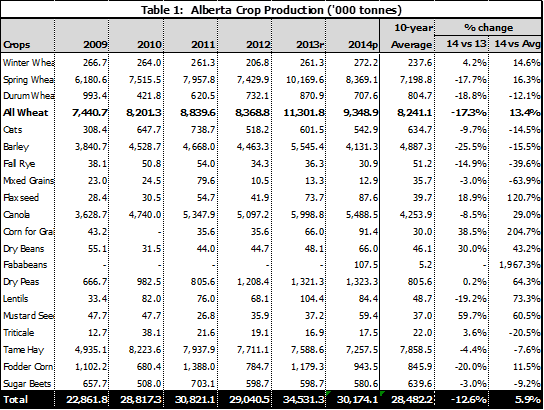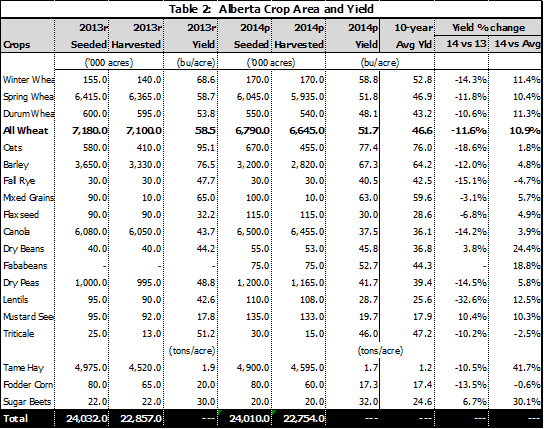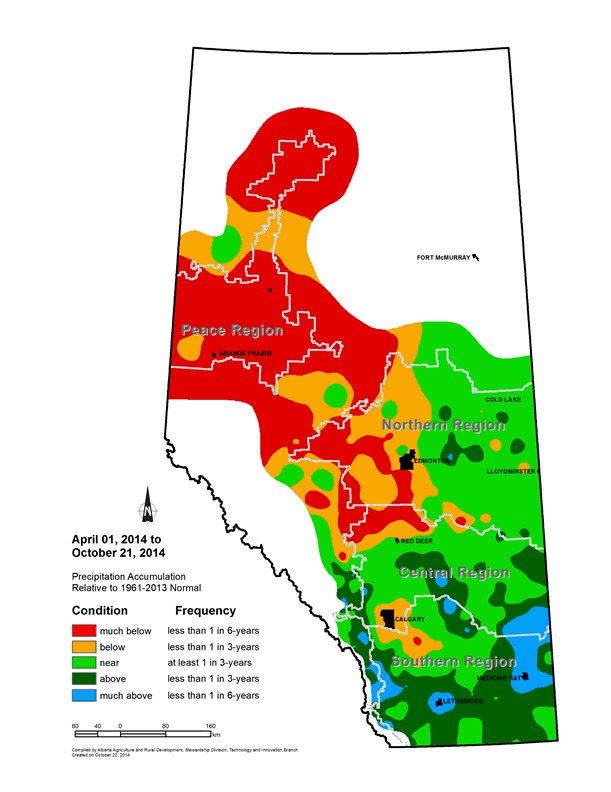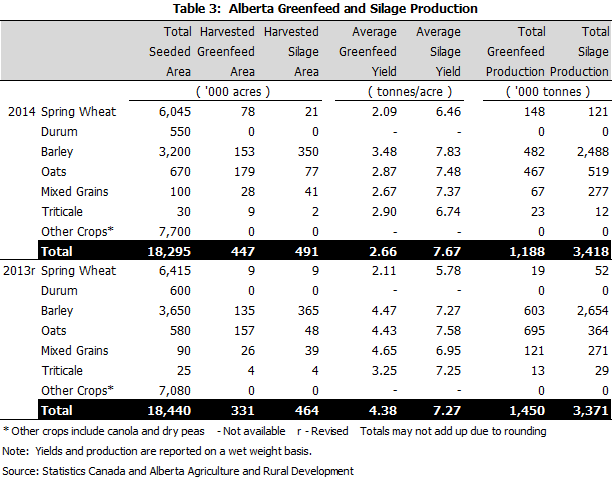| | The 2014 crop season | Insects and crop diseases | Forage and pasture | Alberta crop production, 2014 | Alberta forage production, 2014 | Alberta crop production tables | Precipitation map
.
Overview
This report presents a review of the crop season and an analysis of crop production statistics for 2014. In addition, a precipitation map for the 2014 crop season is attached for reference.
The 2014 Crop Season
Crop growing conditions in the province during 2014 were mainly favorable, despite the hot and dry weather in July and August, and heavy snow and frost in early September. These conditions provided producers with the opportunity for an above average harvest, with generally about average crop quality and yields. Provincial average yields were below the 2013 record year, but were still above their 10-year averages for most major crops.
The cool spring weather conditions, including rain, frost and snow hindered soil warming and delayed seeding in some areas, especially in the South and Central Regions. Despite this, producers took advantage of a few warmer days with more than 47 per cent of crops seeded as of May 20, 2014. This was about 20 per cent behind the 10-year average. Provincially, surface soil moisture ratings were favorable and rated 93 per cent good to excellent. By the last week of May the conditions had improved significantly, allowing seeding to progress more rapidly.
In June, a return to cooler temperatures and more precipitation resulted in delays in crop development in most areas. This was particularly so in southwestern Alberta, where heavy rains during mid June brought upwards of 100 mm of moisture. Surface soil moisture conditions were reported at 78 per cent good to excellent as of June 17, 2014. Despite cool temperatures earlier in the spring, producers were able to complete seeding by early June.
An extended period of warm temperatures and timely precipitation across most regions in the province significantly advanced crop development in July. Provincial crop condition ratings remained favourable with 77 per cent of crops rated in good to excellent condition as of July 15, 2014. For the remainder of July, weather patterns shifted to frequent rain showers, which was very beneficial for both yield and crop maturity. By the end of July, surface soil moisture conditions were rated 74 per cent good to excellent. As a result of the wet weather in late July and the cool temperatures early in the season which retarded growth, haying operations were delayed, resulting in yield and quality being below average.
The return of warm and dry weather throughout most of August rapidly enhanced crop development and brought crops to maturity. Overall, crop conditions across most parts of the province were slightly behind 2013, especially in the South Region, due to hot, dry weather and lack of moisture. Harvest started by the end of August, but progressed slowly due to a mix of rain and frost in some areas of the province. Harvest was most advanced in the Peace Region due to extremely dry conditions. Provincially, four per cent of crops were harvested as of August 26, 2014.
In September, an early snowfall and cool weather delayed crop harvest in most areas across the province, especially in the South, Central and North West Regions. In the northern part of the province, temperatures dropped to -2°C to -3°C, which affected crop quality. Preliminary estimates for dryland yield were reported about average for most crops. During the last two weeks of September, producers were able to make good harvest progress given the warm, dry weather. As of September 30, 2014 it was estimated that 72 per cent of the crops were in the bin, which was on par with their 10-year averages.
The continuation of dry, warm weather allowed producers to complete crop harvest by end of October. Overall, crop yields in the province in 2014 were 5 to 15 per cent above their 10-year averages. The highest yields were recorded in the North West Region. In terms of crop quality, grade estimates for both cereals and oilseeds were about average, mainly as a result of the hot and dry conditions in July and August, and the cool, wet weather in September. The best quality grades were reported in the Peace Region.
Insects and Crop Diseases
In 2014, crop damage from pest infestations was less severe compared to previous years. The most noticeable damage was from cabbage seedpod and pea leaf weevils , wheat midge, bertha armyworm, flea beetles, lygus bugs and grasshoppers. Cabbage seedpod weevils numbers were down compared to last year, but were still a concern, as their populations had spread north. Pea weevils were an unexpected problem and a severe concern in the Southern Region, where they caused far more damage than in previous years. Wheat midge caused some damage in the Peace and Central Regions, while elsewhere in the province the threat was minimal. Lygus bugs were a less severe problem compared to 2013, with the Southern Region of the province being the most problematic area. Fewer crops were sprayed for bertha armyworm compared to the previous years, but was still a concern in Southern and Central Alberta. Overall, the Southern Region was the hardest hit by pests. There were some problems with grasshoppers infestation in 2014, especially in some parts of the Central Region. For most of the other areas in the province this was a non-issue.
For the fifth consecutive year, damp weather conditions in spring and early summer contributed to crop diseases in many areas in the fall, notably for fusarium head blight, sclerotinia and clubroot. The damage from crop disease outweighed the damage from pests. Fusarium head blight is becoming an increasing problem in Alberta, especially in the Central Region. Some incidents of sclerotinia were reported throughout the province, and were common in many crops including canola, dry beans, sunflower and peas. Sclerotinia appeared mainly in Northern Alberta due to the wet weather, although the extent of damage caused by this disease is unknown. The spread of clubroot also caused some damage, mainly in the Central Region but was also present in the North East and North West Regions. Northern Alberta remained clubroot disease free due to dry weather.
Forage and Pasture
In May, pasture had a slow start across the province, due to cool weather conditions, especially in the South and Central Regions. Winterkill resulted in the reseeding of some fall crops. Provincially, May pasture conditions were reported as one per cent poor, 24 per cent fair, 64 per cent good, and 11 per cent excellent. Throughout the summer, pasture ratings declined and by August it was 60 per cent as good to excellent due to hot, dry weather. By September, the ratings had dropped to 42 per cent as good to excellent, due to dry weather and a lack of precipitation.
With respect to tame hay, production was down from 2013, due to lower yields, despite harvested area being up. The drop in yields was mainly due to the cool temperatures early in the season which retarded growth. The dry, hot weather in August facilitated the harvest for first cut hay, with quality rated as good to excellent. The second cut had some rain, but nonetheless quality was still rated as good to excellent.
Alberta Crop Production, 2014
Total 2014 Crop Production Decreased in Alberta
On December 4, 2014, Statistics Canada released its third and final estimates of crop production for Canada and provinces. Based on this report, total 2014 production of principal field crops in Alberta was estimated at 30.2 million tonnes, 12.6 per cent lower than last year, but still 5.9 per cent above the 10-year average for 2004-2013 (see Table 1). Provincial average yields are estimated to be below last year, but still remain above their 10-year averages for most major crops (see Table 2). Crop quality was generally about average. In 2014, total seeded and harvested areas of principal field crops in the province declined 0.1 per cent and 0.5 per cent, respectively.
Production by Crop Type, Alberta
Total production of spring wheat in 2014 decreased 17.7 per cent from 2013, to 8.4 million tonnes, and was 16.3 per cent above the 10-year average. The lower production stems from a decline in yield and harvested area. Yield was down 11.8 per cent, while harvested area declined 6.8 per cent from 2013. The provincial average yield was 51.8 bushels per acre and harvested area at 5.9 million acres. For durum wheat, production was down 18.8 per cent, to 707,600 tonnes. Durum production dropped 12.1 per cent below the 10-year average. The decrease was due to harvested area falling 9.2 per cent to 540,000 acres, while average yield decreased 10.6 per cent to 48.1 bushels per acre. Overall, production of all wheat was 9.3 million tonnes, a decrease of 17.3 per cent from 2013.
Total barley production declined to 4.1 million tonnes, down 25.5 per cent from last year. The lower production was attributed to a 12.0 per cent lower yield of 67.3 bushels per acre, and a 15.3 per cent decline in harvested area at 2.8 million acres. Barley production dropped 15.5 per cent below the 10-year average.
Total canola production decreased from last year’s all time high by 8.5 per cent to 5.5 million tonnes. This was still the second highest production on record, and remained 29.0 per cent above the 10-year average. The decrease was due to lower yield, down 14.2 per cent to 37.5 bushels per acre. Yield was only 3.9 per cent above the 10-year average. The decrease in yield more than offset a 6.7 per cent increase in harvested area at 6.5 million acres. The total harvested acres in 2014 are the second highest on record.
Dry peas production rose marginally to a record 1.3 million tonnes. Harvested area was up 17.1 per cent to 1.2 million acres, while yield fell 14.5 per cent to 41.7 bushels per acre.
Total oat production fell 9.7 per cent to 542,900 tonnes, and was 14.5 per cent below the 10-year average. The decline was attributed to a drop in yield. The average yield declined 18.6 per cent to 77.4 bushels per acre. This could not be compensated for by harvested area increasing 11 per cent to 455,000 acres.
2014 Crop Production, Canada
Based on the November estimates, total 2014 Canadian production was 21.2 million tonnes for spring wheat, 5.2 million tonnes for durum, 7.1 million tonnes for barley, 2.9 million tonnes for oats, 15.6 million tonnes for canola, and 3.4 million tonnes for dry peas.
Alberta Forage Production, 2014
Total tame hay production in Alberta in 2014 was estimated at 7.26 million tonnes, based on the Statistics Canada report “November Estimate of Production of Principal Field Crops, 2014”. This was down 4.4 per cent from 2013, and 7.6 per cent below the 10-year average. The decline in production was as a result of lower yields, down 10.5 per cent from last year, despite harvested area increasing 1.7 per cent to 4.6 million acres.
Based on a survey conducted by the Statistics and Data Development Branch of Alberta Agriculture and Rural Development, total greenfeed production in the province decreased 18.1 per cent from 2013, to 1.2 million tonnes (Table 3). The lower production was attributed to a marked decrease in yields, given the higher harvested area. For silage, total production was estimated at 3.4 million tonnes, up 1.4 per cent from 2013, due to higher yields and harvested area.
The hot, dry weather in August contributed to lower yields for greenfeed, even though silage yields increased. The provincial average yield for greenfeed was estimated at 2.66 tonnes per acre. This was 39.3 per cent below 2013. For silage, the provincial average yield was estimated at 7.67 tonnes per acre, up 5.5 per cent from 2013.
Producers reported a higher total harvested area for greenfeed, which was up 35.1 per cent from 2013, to 447,000 acres. Silage acreage also increased 5.8 per cent, to 491,000 acres. Barley and oats were the major crops harvested for greenfeed and silage production, although significant acreages of spring wheat, mixed grains, and some triticale were also taken off as forages.
Contacts
For additional information relating to this report, please do not hesitate to contact the author.
This report is also available on the Internet at:
http://www1.agric.gov.ab.ca/$department/deptdocs.nsf/all/sdd4191
Alberta Agriculture and Rural Development
Economics and Competitiveness Division
Statistics and Data Development Branch
Lukas Matejovsky
Crop Statistician
780-422-2887
Email: lukas.matejovsky@gov.ab.ca
Alberta Crop Production Tables



Precipitation Map for the 2014 Crop Season

Source: Alberta Agriculture and Rural Development, Environmental Stewardship Division, Technology and Innovation Branch
 |
|